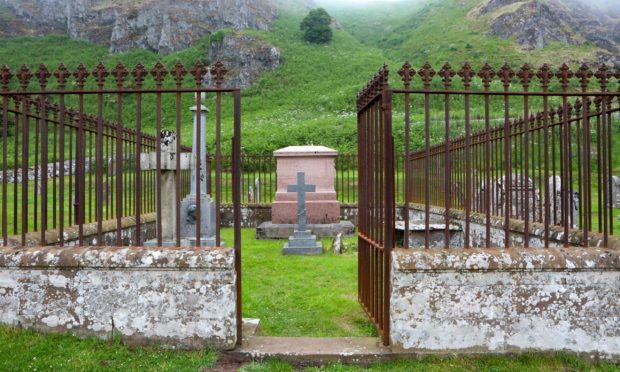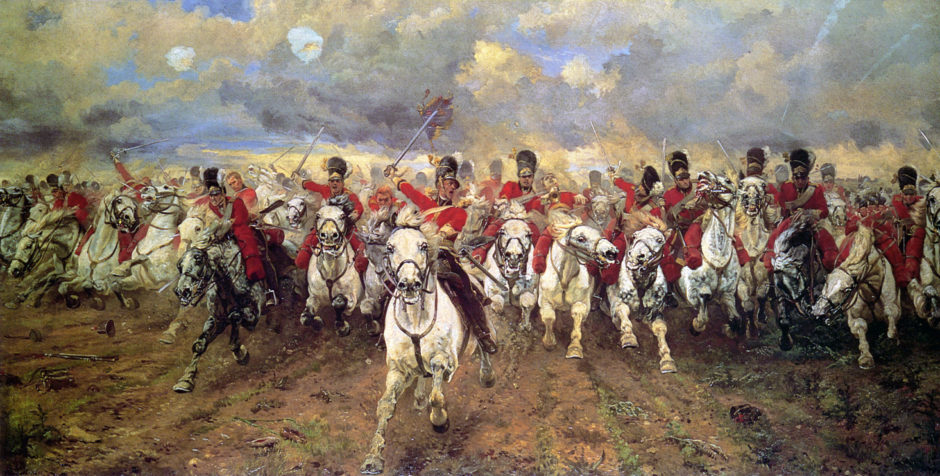An imposing headstone stands behind iron railings in an old cemetery near Montrose.
It marks the grave of Sir Joseph Muter who, 205 years ago this week, played a key role in the final defeat of Napoleon Boneparte at the battle of Waterloo.
Napoleon’s forces had swept across Europe and far beyond, but in 1812 he met with disaster in Russia and by 1814, cornered in Paris, he abdicated and was sent to Elba in exile.
The next year, he escaped and landed back in France with fewer than 1000 men.
The French once more flocked to his banner and the Emperor’s old adversaries again mustered for war.
The Duke of Wellington chose Waterloo to face down the ‘Corsican Ogre’.
For Wellington, holding the high ground against the French onslaught was vital as he waited for the Prussian army to arrive and reinforce him – but it would be a long wait.
By early afternoon, Wellington’s lines had weakened and with no sign of the Prussians, the French, sensing victory, sought to deliver a hammer-blow that would destroy Wellington and allow them to pivot onto the Prussians.
As the smoke from cannon and musket fire drifted across the battlefield, 18,000 French infantrymen with cavalry support under the command of the Count d’Erlon, began the advance across the field and up the slope to the ridge held by Wellington’s troops.
Heavy cannon-fire failed to halt the d’Erlon’s troops who, advancing in column, reached the crest of the ridge and began to deploy into line.
The French ran into volley after volley from the redcoats but continued their relentless advance.
Fighting was now taking place all along the ridge.
From where Napoleon stood, it must have seemed as though the day was his as the Imperial Eagles moved forward, glinting in the sunlight.
What he did not see, was the Union Brigade and Household Brigade of heavy cavalry that waited on the reverse slope of the ridge.
The Union brigade, so called because it contained regiments from England, Scotland and Ireland, 1st Royal Dragoons, the Scots Greys, and 6th Inniskilling Dragoons.
The Inniskillings were under the command of Sir Joseph Muter.
Dragoons are heavy cavalry – large men armed with heavy sabres and mounted on powerful horses.
With perfect timing, the Union Brigade slammed into the French columns and inflicted carnage on the French.
They carried the charge onto Napoleon’s beloved artillery – but they had gone too far.
The French cavalry counterattacked and inflicted heavy losses.
Muter’s Inniskillings had 193 killed or wounded out of 400, plus 190 horses and their butcher’s bill would increase by the end of the day.
But the charge had inflicted heavy losses on the French and bought Wellington precious time for the arrival of the Prussians.
As losses continued, Muter assumed command of the Union Brigade and they fought on. He was wounded around 6pm, with his horse shot twice at the same time.
Wellington and the Prussian forces under the command of Marshal Blucher would end the day victorious.
Napoleon’s reign had lasted just 100 days. He would again go into exile, this time to St Helena from which there would be no escape. He would never see France again.
Sir Joseph Muter
Muter was born in Fife in 1777, his father was a colonel and his mother hailed from near Montrose.
He was educated at Edinburgh University before joining the army in 1794 and made lieutenant in 1795.
Commissioned a captain in the 13th Light Dragoons in 1797, he rose to the rank of major four years later.
After a period of study at the Royal Military College, he was appointed to the staff of the Duke Gloucester and his steady rise through the ranks saw him promoted to the rank of lieutenant-colonel in 1808.
Two years later he embarked for Portugal where he served in three campaigns in the Peninsular and saw action in a number of battles, including Arroyo dos Molinos, where his actions earned him a mention in despatches.
In 1814, he was promoted to full colonel before serving at Waterloo in 1815.
Among the honours he received for his part at Waterloo, were the Companion of the Bath, the Order of St Wladimir of Russia and the Royal Hanoverian Guelphic order.
His wound, caused by a musket ball to his right wrist, became infected and oozed pus and pieces of glove, but he was fortunate not to require amputation.
Writing to his brother after the battle, Muter said: “Our Brigade charged, upset and completely destroyed three heavy columns of infantry at least 9000 – the old Inniskillings behaved most gallantly.”
A year later he inherited an estate at Straton of Kirkside near Montrose and adopted the surname Straton.
A keen antiquarian, he undertook a tour of Egypt, returning with a number of ancient artefacts, including a mummified man, a mummy board and coffin, which he donated to the University of Edinburgh in 1819.
The donation has been credited as the foundation of the National Museum of Scotland’s Ancient Egypt collection.
In 1821, he was elected as Fellow of the Royal Society of Edinburgh and presented a lecture to the society on the Monuments of Thebes.
By 1838 he was a lieutenant general and after a distinguished military career, retired in 1840 due to ill-health. He died the same year.
In his will, Straton left a substantial bequest of £70,000, some £7.1 million in today’s money, to the University of Edinburgh ‘for the provision of and advancement of science’.
He also left £500, the equivalent of £51,300 today, to his old regiment, the Inniskillings.
Sir Joseph is buried in the family plot at Nether Kirkyard, St Cyrus, which is now part of a nature reserve where he requested a tombstone be erected to him.
He died without issue and the estate passed to his nephew, Joseph Muter, who also took the Straton name.
Muter’s group of medals awarded after Waterloo were auctioned in 2010 and sold for £27,000.











